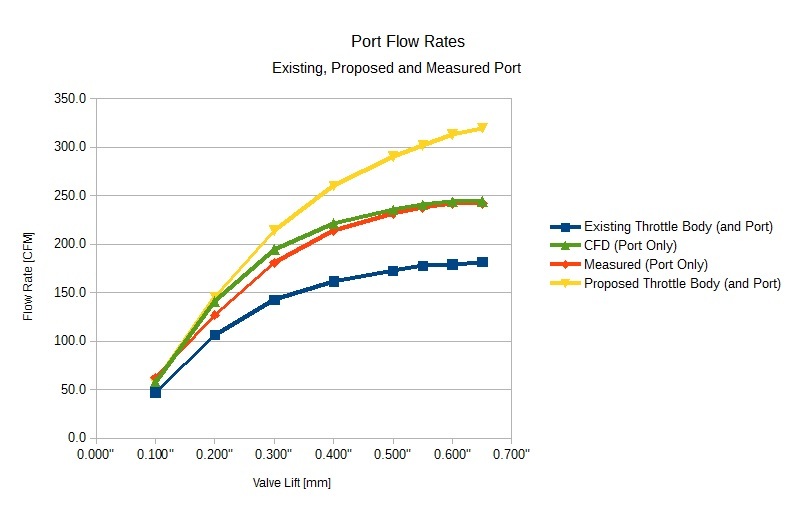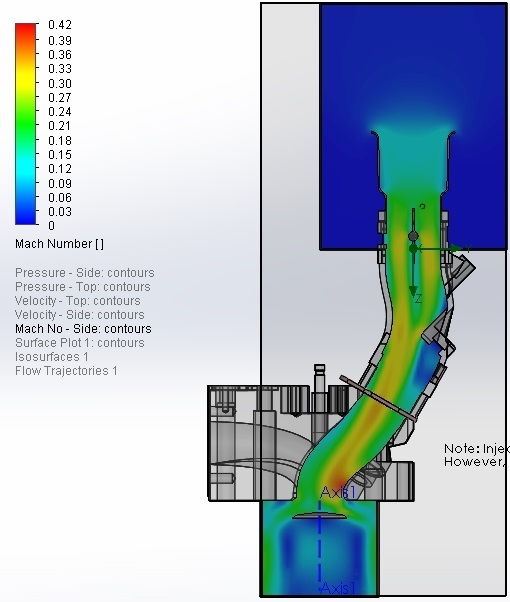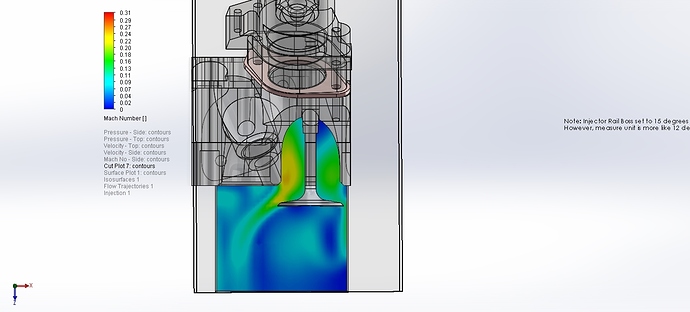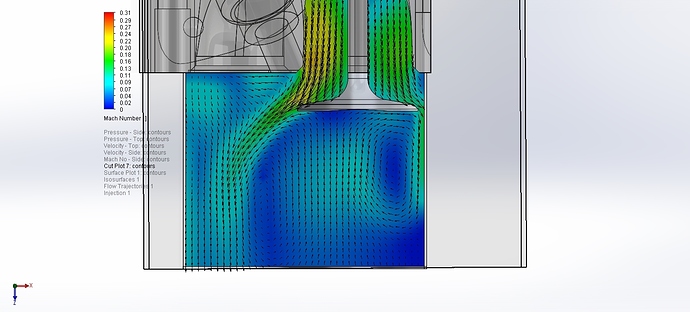I am attempting to rebuild a Jag V12 with a view to achieving in excess of 700bhp in normally aspirated guise. To this end I have been analysing what others have done and have been interesting primarily in asking “what would they do now?” if they could.
The output of the engine is constrained by stress limits in the block and flow/stress limits in the heads. And combustion efficiency. I propose (sometime in the distant future) to publish a web site with details of my investigations into these areas.
I thought I’d open a can of worms by publishing some info on the head flow.
First a note on simulation. In my day job I design stuff. And over the last few years, simulation has become a vital tool in understanding and optimising designs. Fundamental to my design process is to start by simulating a known entity. If the model matches the measured outcome, then you can have increased confidence in the model. Also, there is no substitute for detail. The more care and attention you make to the detail of the model, the closer the simulation result.
More Power!
There have been a number of posts over the years in people asking “what can I do to get more power” and invariably the answer has been “don’t bother with big bore inlets” because the ports are the limiting factor, or something like that.
Let me share some results of a CFD analysis on the inlet ports.
Background
The heads I have analysed are the TWR Gp C ported (flat) heads. I have not yet analysed the standard heads.
My engine was supplied with 12 individual throttle bodies and 12 butterfly valves by someone experienced in “the art” of making power from Jag engines. However, it was almost certain that this was the first time they had built an engine with the potential of the Gp C heads.
The computer model (using Computational Fluid Dynamics) tries to predict the mass of air that flows into the cylinder during an inlet event. The computer breaks up the flow area into thousands of tiny cells and then tries to solve the equations to relate each cell to its neighbour. The result shows velocity, pressure, turbulence and flow separation etc. The output in this case is air mass flow in grams per second into the cylinder cavity with the piston at BDC. I have converted this to cubic feet per minute, not through any love of the imperial system, but rather because the numbers become easier to understand.
The objective in this case is to maximise flow and maximise pressure wave effects (velocity -> momentum).
I have done a lot of work looking into using slide throttles, as there were what were used on the TWR engine. However, my conclusion is that correctly designed butterflies will result in better throttle response, better fuel mixing and almost no impact in maximum flow and be less problematic to maintain.
Baseline Flow
The Gp C head has an inlet port about 39.7mm dia (vs standard of 34.2mm - a 35% increase in area).
The graph shows 4 curves. The green and red curves are the heads flowed without any inlet trumpets or throttles. Red is measured by a tuner on his flow bench, Green is the result of a computer simulation. It is quite close, but I hope to put more effort into the valve seat detail to try to improve the simulation result at low lift. This port is flowing about 240CFM.
The Blue Curve
The is the flow through the identical port but with the throttle bodies and trumpets as supplied by the engine builder. The flow rate is now constrained to about 182CFM. Identical ports and valve. Restrictions are apparent in mismatched bore sizes between spacers, gaskets and throttle body (resulting in detached flow). The trumpet has a poorly formed inlet radius. The injector housing is copied from factory standard and protrudes alarmingly into the airflow. The butterfly is a traditional (8mm - 5/16") shaft with two screws. The screws were protruding considerably out the other side of the shaft, where they are split to prevent loosening but as a result are waving around in the airflow.
The Yellow Curve
Again, this is an identical port and valve. However, in this case, the trumpet has been designed based upon best principles. The butterfly is a shaft-less design I have developed with certain aerodynamic details. The injector intrusion has been optimised and the internal geometries have been tweaked to discourage flow separation and maintain velocity. Flow rate is 320CFM.
The other interesting observation is that in the case of the yellow curve, the flow rate is still increasing with additional valve lift. (Often people say there is no need to open the valve beyond a certain limit, because the curtain area is already greater than the port area).
Conclusion
I really just wanted to draw peoples attention to the fact that, despite the port being identical in all cases, the actual air flow into the cylinder is highly sensitive to detail changes in the upstream inlet arrangement.
I would venture to suggest that “the blue curve” is pretty representative of much of our enthusiastic efforts. The hardware looks great. A lot of wow factor. It would probably produce a great result on a stock head and be totally acceptable for up to 450-500bhp. (Which agrees with preliminary dyno results)
I expected a small improvement in optimising each component based upon the best published research I could find. I was completely unprepared for the size of the improvement. A 76% increase in flow is not to be sneezed at. And this suggests that the potential for this engine configuration is comfortably in excess of 700bhp. (Which agrees with published figures from TWR)
Cheers
Mark






